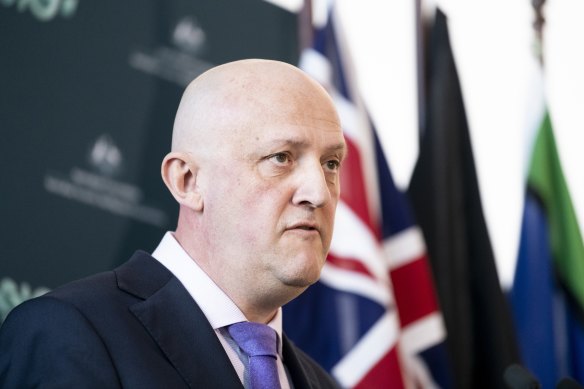This was published 2 years ago
ASIO drops terrorism threat level to possible for first time since 2014
The country’s top spy agency has lowered the national terrorism threat level below “probable” for the first time in eight years, reflecting a reduced risk of violence by radical Islamists.
The director-general of the Australian Security and Intelligence Organisation, Mike Burgess, said he had taken the repatriation of Australian relatives of Islamic State fighters from Syria into account when deciding to reduce the terrorism threat level from probable to possible.

ASIO director-general Mike Burgess has lowered the national terrorism threat level below “probable” for the first time in eight years.Credit: Rhett Wyman
ASIO elevated the national terrorism threat level to probable in 2014, a time when significant numbers of radicalised foreign fighters, including Australians, were travelling to Syria and Iraq to join Islamic terrorist groups.
“A decision of this nature is not taken lightly or made casually,” Burgess told reporters in a press briefing at ASIO’s Canberra headquarters on Monday.
“The process involves a large number of people and a significant amount of time.”
Burgess said it was important to note the assessment assumes there are no “radical shifts to Australia’s policies, processes, laws or investments”.
But he said this was not a reference to the government’s repatriation of Australian women and children from camps in Syria, which began last month with a group of four women and 13 children.
The government is expected to conduct further repatriation missions to bring back some of the remaining 43 people to Australia but has not confirmed details.
Burgess said some repatriated Australians may need to be monitored after their return.
“That’s ok because I’ll back my organisation any day,” he said.
Burgess said ASIO had conducted risk assessments involving face-to-face interviews with the entire cohort of Australians in the camps.
Burgess announced in ASIO’s annual report that foreign interference had overtaken terrorism as the agency’s principal national security concern.
Burgess stressed the threat of terrorism had not extinguished and that “possible” does not equate to “negligible”.
“It remains plausible that someone will die at the hands of a terrorist in Australia within the next twelve months,” he said.
“Individuals are still fantasising about killing other Australians, still spouting their hateful ideologies in chat rooms, still honing their capabilities by researching bomb-making and training with weapons.
“Critically, though, there are fewer of these people than there were previously, and fewer of them are likely to conduct an actual attack in Australia.”
The most important factor in reducing the threat level was the reduction in risk posed by religiously motivated violent extremists, he said.
“The offshore networks, capabilities and allure of groups such as ISIL and al-Qaeda have been degraded, with their support in Australia declining accordingly,” he said.
“But I stress: it’s dissipated, not disappeared.”
The most likely terrorist attack in Australia involves a lone actor using a basic, easily obtained weapon such as a knife or vehicle, he said.
Home Affairs Minister Clare O’Neil said the government and security agencies would “remain vigilant”.
“Terrorism doesn’t stand still, and neither will we.”
Cut through the noise of federal politics with news, views and expert analysis from Jacqueline Maley. Subscribers can sign up to our weekly Inside Politics newsletter here.